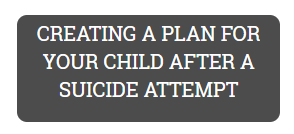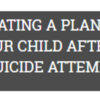During the last decade, the number of emergency room and hospital visits linked to suicidal thoughts and suicide attempts among children nearly doubled, according to a study in Pediatrics. This was especially true among youth 15 to 17 years of age. Experts say that bullying, trauma, and abuse are often underlying factors.
Developing a WRAP
One of the most important post-discharge needs for a child who has attempted suicide is to have a safety plan in place. Also referred to as a Wellness Recovery Action Plan, a WRAP is a go-to resource that a child can use when they feel stressed, need additional support, or experience a crisis. A WRAP can include the following:
- A list of your child’s “triggers.”
- Early warning signs that might suggest your child is feeling sad or stressed before those emotions become overwhelming.
- A roster of trustworthy, non-judgmental family members and friends to be called upon during periods of stress or crisis.
- Relaxation exercises and stress-reduction techniques.
- Affirming words and activities to remind your child of their positive qualities.
- Reminders and tips to eat healthfully, exercise, and sleep.
- A list of people and organizations not to call to avoid further stressing out your child.
- Who to call (911, local crisis center, suicide prevention hotline, your child’s therapist or pediatrician) and where to take your child for medical care in a crisis.
If you are a parent of a child who has experienced suicidal thoughts or actions, one of the most important things to remember is that you are not alone. Help is available for both your child and you—these resources may provide additional assistance:
- A Voice at the Table
- NAMI Family-to-Family educational program
- NAMI Family Support Group
- National Suicide Prevention Lifeline
- gov
- The Trevor Project (for LGBTQ+ teens and young adults)
To read more of Alexis Anderson's article, please click here.



Comments (0)